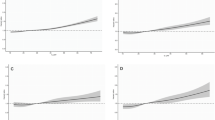Abstract
Objectives
Concern on human renal toxicity and carcinogenicity of trichloroethylene is based on findings of increased incidences of renal cell cancers in persons with long-lasting and high occupational exposures to this solvent. The full tumour development is likely to require promotional stimuli, by repetitive episodes of high peak exposures to trichloroethylene, leading to nephrotoxicity. This process is visualised by the excretion of tubular marker proteins in the urine of exposed persons. For this purpose, surveillance of α1-microglobulin excretion is being suggested by the Deutsche Forschungsgemeinschaft.
Methods
The present study assessed the applicability of α1-microglobulin as a biomarker of proximal tubule damage in the prevention of nephrotoxicity by trichloroethylene exposures. For this purpose, α1-microglobulin excretions were assessed in trichloroethylene-exposed and non-exposed subgroups of both cases (diseased with renal cancer) and controls (not diseased with renal cancer) of a recent case–control study.
Results
The median of α1-microglobulin excretions in non-exposed persons was below the detection limit, but it was clearly elevated in exposed persons. The Wilcoxon rank sum test showed a significant difference (P=0.0090). Consistent with the underlying concept, renal cell cancer cases who had been exposed to trichloroethylene had higher α1-microglobulin excretions than non-exposed cases (P=0.0005) and also had higher α1-microglobulin excretions than exposed controls (P=0.0004). Of 20 trichloroethylene-exposed renal cell cancer cases only three (15%) displayed a normal α1-microglobulin excretion of <5 mg/l. By contrast, 41 (52%) out of 79 non-exposed renal cancer cases showed normal excretions of the biomarker.
Conclusion
The present data are in agreement with the concept of pathogenesis of renal cell cancers developing under high (suggested: >500 ppm peak exposures) and long-term (several years) exposure to trichloroethylene. They also visualise the potential value of α1-microglobulin excretion as a routine biomarker of renal toxicity that may be used in the medical surveillance of trichloroethylene-exposed persons.
Similar content being viewed by others
References
Brauch H, Weirich G, Hornauer MA, Störkel S, Wöhl T, Brüning T (1999) Trichloroethylene exposure and specific somatic mutations in patients with renal cell carcinoma. J Natl Cancer Inst 91:854–861
Brüning T, Bolt HM (2000) Renal toxicity and carcinogenicity of trichloroethylene: key results, mechanisms and controversies. Crit Rev Toxicol 30:253–285
Brüning T, Golka K, Makropoulos V, Bolt HM (1996) Preexistence of chronic tubular damage in cases of renal cell cancer after long and high exposure to trichloroethylene. Arch Toxicol 70:259–260
Brüning T, Sundberg AGM, Birner G, Lammert M, Bolt HM, Appelqvist EL, Nilsson R, Dallner R (1999a) Glutathione transferase alpha as a marker for tubular damage after trichloroethylene exposure. Arch Toxicol 73:246–254
Brüning T, Mann H, Melzer H, Sundberg AGM, Bolt HM (1999b) Pathological excretion patterns of urinary proteins in renal cell cancer patients exposed to trichloroethylene. Occup Med 49:1–7
Brüning T, Pesch B, Wiesenhütter B, Rabstein S, Lammert M, Baumüller A, Bolt, HM (2003) Renal cell cancer risk and occupational exposure to trichloroethylene: results of a consecutive case–control study in Arnsberg, Germany. Am J Ind Med 42:274–285
Deutsche Forschungsgemeinschaft (DFG) (2003) Trichlorethen, Addendum. In: Drexler H, Greim H (eds) Arbeitsmedizinisch-toxikologische Begründungen von BAT-Werten. VCH, Weinheim
Golka K, Hartert-Raulf T, Schöps W, Kierfeld G, Brüning T, Bolt HM (1997) Subclinical changes in urinary protein excretion of renal cell cancer patients: effect of high occupational exposures to trichloroethylene. Cent Eur J Occup Environ Med 3:167–174
Green T, Ong CN, Ng V, Ong HY, Zhuang ZX, Yang CF, Bloemen L (2004) Biological monitoring of kidney function among workers occupationally exposed to trichloroethylene. Occup Environ Med (in press)
McGoldrick TA, Lock EA, Rodilla V, Hawksworth GM (2003) Renal cysteine conjugate C-S lyase mediated toxicity of halogenated alkenes in primary cultures of human and rat proximal tubular cells. Arch Toxicol 77:365–370
Mensing T, Welge P, Voss B, Fels LM, Fricke HH, Brüning T, Wilhelm M (2002) Renal toxicity after chronic exposure of rats to trichloroethylene. Toxicol Lett 128:243–247
Vamvakas S, Brüning T, Thomasson B, Lammert M, Baumüller A, Bolt HM, Dekant W, Birner G, Henschler D, Ulm K (1998) Renal cell cancer correlated with occupational exposure to trichloroethylene. J Cancer Res Clin Oncol 124:374–382
Acknowledgments
The authors thank the Deutsche Forschungsgemeinschaft for financial support (T.B.: BR 1825/3–1; H.M.B. and S.S.: SFB 475). Many thanks are due to Mrs. Doris Dannappel for working on the logistics of the study.
Author information
Authors and Affiliations
Corresponding author
Rights and permissions
About this article
Cite this article
Bolt, H.M., Lammert, M., Selinski, S. et al. Urinary α1-microglobulin excretion as biomarker of renal toxicity in trichloroethylene-exposed persons. Int Arch Occup Environ Health 77, 186–190 (2004). https://doi.org/10.1007/s00420-003-0500-3
Received:
Accepted:
Published:
Issue Date:
DOI: https://doi.org/10.1007/s00420-003-0500-3




